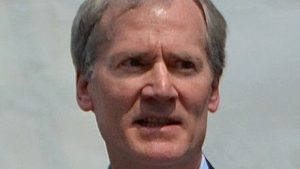Marc Tessier-Lavigne, whose resignation as president of Stanford University becomes effective today, is retracting two papers from Science following an institutional investigation that found data manipulation in multiple figures.
Both articles, “Hierarchical Organization of Guidance Receptors: Silencing of Netrin Attraction by Slit Through a Robo/DCC Receptor Complex,” and “Binding of DCC by Netrin-1 to Mediate Axon Guidance Independent of Adenosine A2B Receptor Activation,” were published in 2001, when Tessier-Lavigne, the corresponding author, was at the University of California, San Francisco. They have been cited well over 600 times in total, according to Clarivate’s Web of Science.
Anonymous users on PubPeer posted concerns about potentially manipulated images in the papers as early as 2015. Reporting by The Stanford Daily in November 2022 spurred the university to launch an investigation into several of Tessier-Lavigne’s papers, how he responded when others identified issues in his articles, and the culture of his lab.
The university published the final report last month, finding that four of the five papers it reviewed on which Tessier-Lavigne was a principal author contained “apparent manipulation of research data by others.” Tessier-Lavigne, the investigation committee concluded:
did not have actual knowledge of the manipulation of research data that occurred in his lab and was not reckless in failing to identify such manipulation prior to publication.
The two Science papers were among those in which the panel identified manipulated data. In a statement posted to his lab website on July 19, the same day as the report was published, Tessier-Lavigne wrote that he planned to retract the articles.
Tessier-Lavigne did not respond to our request for comment, nor did Elke Stein, the first author on both papers. The notices state Stein, who is the only other author besides Tessier-Lavigne on one of the papers, did not agree with either retraction.
Tessier-Lavigne was aware of the issues raised on PubPeer, according to the investigation report. In 2015 he submitted corrections for the two papers to Science that attributed the issues to a software phenomenon called “tiling” rather than data manipulation. In fact, the panel members wrote in the report:
Tiling does not explain the underlying image manipulations in at least some of the figures to which the explanation was intended to apply.
“Due to an error,” the journal did not publish the corrections, Holden Thorp, editor-in-chief of the Science family of journals, acknowledged to the journal’s editorially independent news division.
After June 2016, Tessier-Lavigne did not follow up about the corrections that were never published, Stanford’s report stated. Instead, it described times he “failed to decisively and forthrightly correct mistakes in the scientific record.”
In March 2021, scientific sleuth Elisabeth Bik posted a comment on PubPeer pointing out the journal’s apparent lack of action on concerns raised about one of the papers and added a few findings of her own.
Her comment prompted Tessier-Lavigne to draft an email to Science asking about the status of the two corrections, according to the report, but he never sent it.
Tessier-Lavigne told the investigation panel he “has a practice of drafting many e-mails to see how they read but only sends a portion of them and that he concluded the communication was unnecessary,” according to the report. The panel wrote that his decision not to follow up on the corrections “was insufficiently attentive to the continuing need to correct the scientific record.”
In December 2022, after the Stanford Daily story drew attention to the issues with the papers, Science published editorial expressions of concern for both articles, signed by Thorp.
The notices acknowledged and described the 2015 corrections that were never published, and alluded to “additional concerns.” Thorp wrote that the journal was not proceeding with the corrections, but “alerting readers to the concerns while the authors and the authors’ institution investigate further.”
The retractions, posted today, recap the papers’ history of publication, corrections that never appeared, and expressions of concern. Both notices state that an institutional investigation “is complete and has identified further issues, including manipulation of data-containing portions” in multiple figures, “undermining confidence in the paper’s conclusions.”
Tessier-Lavigne signed both notices, and wrote:
I regret the impact of these issues on the scientific community.
Author retractions, such as Tessier-Lavigne’s, make up the bulk of the retractions Science has published in the last six years, a journal spokesperson told us – 14 of 16 issued since 2018.
After receiving an author’s request for retraction, the spokesperson said:
The role of the journal is to evaluate the request and make a decision based on various considerations, including the validity and seriousness of the concerns raised. At Science, we follow guidelines for retractions set by the Committee on Publication Ethics (COPE) to help ensure that the retraction process is fair, transparent, and consistent across different publications. For any retraction request by an author, we need to confirm that the retraction request aligns with COPE guidelines. In the event of an author retraction request, Science also reaches out to all authors of the paper to determine whether they agree to authorship of the retraction. In cases where there has been an institutional investigation, Science is guided by committee recommendations as well. Upon its decision, the journal must prepare to communicate openly with its readership about the retraction.

Bik, who raised new concerns about one of the Science papers on PubPeer in 2021 and evaluated the potential issues in Tessier-Lavigne’s publications for Theo Baker, the Stanford student journalist who broke the story, told us she had not expected the two papers would be retracted:
I expected that the issues that had been raised on PubPeer would perhaps not be rising to the level where Science would think it necessary to retract after so many years, but they did.
“In the past, both parties dropped the ball,” she said of Tessier-Lavigne and Science failing to publish the agreed-upon corrections. “I think now they’re making up for it.”
Expressions of concern like the ones Science published after Baker’s story are a “very good and underused method to flag a paper when under investigation,” Bik said.
From that point on I think the whole retraction process has been handled well by the journal. At least compared to other journals.
Bik credited “the bravery of the student-run newspaper” for shining a light on the concerns an anonymous person raised back in 2015:
It’s only because of coverage by the news that these things have finally been addressed. They should have been addressed a long time ago.
Like Retraction Watch? You can make a tax-deductible contribution to support our work, follow us on Twitter, like us on Facebook, add us to your RSS reader, or subscribe to our daily digest. If you find a retraction that’s not in our database, you can let us know here. For comments or feedback, email us at [email protected].

Believe the science
There are too many doctors in the US. We only need 20,000 a year and there are 50,000 + receiving their doctorate each year. The excess doctors know that they can only justify their paychecks by creating even more excess doctors so they turn a blind eye to all sorts of shenanigans and participate themselves.